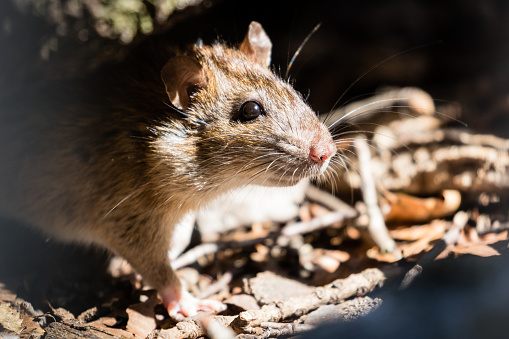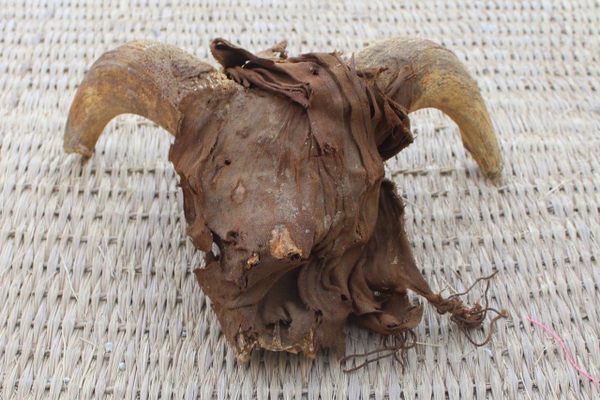In Colonial Williamsburg, Thieving Rats Save History
Historians owe a debt of gratitude to these furry pilferers.
Sometime during or just after the Civil War, a black rat in Williamsburg, Virginia, came into possession of a rare trophy: a solid silver fork. The rodent—a member of the ubiquitous species Rattus rattus, which arrived in North America with the Jamestown colonists—was living between the walls in a building that had variously been a home, a shop, a school, and a popular tavern. The rat’s family had likely been there for generations, gradually adding scraps of paper, fabric, crockery, bones, and miscellaneous debris to its massive nest. Pilfering the fork, however, was an unusual accomplishment for a creature that weighed about half a pound.
“This was not a little tiny dessert fork—it was a dinner fork,” marvels Dani Jaworski, manager of architectural collections at the Colonial Williamsburg Foundation, which came into possession of the tavern building and all its hidden treasures in the 1960s.
That fork—which a maker’s mark dates to between 1861 and 1865—is one of countless objects that the rats of Williamsburg have pushed, dragged, or carried between their teeth to line and decorate their nests since the city became Virginia’s capital in 1699. In the years since Colonial Williamsburg was established as a living history museum in the 1930s, about 1,000 objects of interest have been recovered from historical rat nests, and Jaworksi, the resident rat nest expert, has examined and sorted them into a well-ordered collection.
“Rats are actually little archivists,” Jaworski says, noting that black rats, which rarely range more than 150 feet from their nests, collect a surprising variety of items, which can serve as evidence about what and how people ate, the books and newspapers they read, how they dressed, what they did for work, and how they furnished their homes. “A rat’s nest is a snapshot of people who are long gone.”

Rat nest archaeology has taken off over the past 30 years, particularly in the American South, where it can be particularly valuable to the study of enslaved people, whose lives may otherwise have gone unrecorded. The 1808 Nathaniel Russell House in Charleston, South Carolina, for example, has long been admired for its neoclassical architecture—but it was also the home of rats, whose collection of buttons, bones, utensils, and scraps of paper turned up during the recent restoration of the mansion’s kitchen. At Poplar Forest, Thomas Jefferson’s retreat in western Virginia, rat nests in the walls have included game pieces, scraps of newspaper, gnawed bits of furniture, and even an entire shoe.
“The observation, collection, and analysis of rats’ nests in a domestic context provides researchers with a rare glimpse of day-to-day human life not found in typical archaeological data,” writes Travis McDonald, Poplar Forest’s director of architectural restoration, in a treatise on the value of rats as inadvertent preservationists. “[I]t is the random, everyday collecting of site-specific contextual and commonplace items that provides such useful information to those studying history.”
At Colonial Williamsburg, rat nests have most recently offered hints about the history of the Bray School, a building where Black children were educated in the late 18th century.
“The school is incredibly important, and that story is incredibly important,” says Matt Webster, Colonial Williamsburg’s executive director of architectural preservation, who led the effort to move the school from the campus of the nearby College of William and Mary into the Colonial Williamsburg area after research confirmed its significance in 2021.
It’s a stroke of luck that the humble school building, which was later a private home and, briefly, a dormitory for female students, was preserved over the centuries, Webster says. Now, it is helping to tell a long-overlooked story about Black life in Williamsburg. Bray Schools were part of a religious movement to educate Black children, primarily so they could read the Bible and spread scripture to their community. The schools were not abolition-minded—in fact, they taught enslaved children to accept their lot in life and obey their enslavers—but their existence is surprising in light of later prohibitions on educating enslaved people. Evidence suggests that as many as 400 children attended the school during its 14 years in operation.

Webster and his colleagues have used techniques including paint analysis and dendrochronology—dating by tree rings—to investigate the building, but as with any structure of its vintage, the Bray School was also home to rats, who packed plenty of treasures into its walls. And as their nests turned up during the recent restoration, Jaworski, whose tools of the trade include a dust mask, gloves, and a magnet for safely picking up needles and pins, was called in to remove them and catalog their contents.
“We’ve found different kinds of buttons, some dateable, some not,” she says. “There’s a really neat, really crude wooden one that’s most likely 18th-century.” There are fragments of letters and a William and Mary football ticket from 1937. A straight pin—iron with a glass ball on the end—was lost to a Bray School rat in the 18th century. One of the earliest mechanical pencils ever made in the U.S.—silver alloy, with the mark of its Brooklyn manufacturer, Woodwards & Hale—dates to the 1830s.
“It’s sometimes a little disturbing as to what these rats are picking up and actually bringing into their nest,” Webster says. “Some of them are highly motivated!”
The long-dead humans who lost their pencils, forks, or football tickets to rats would probably have preferred not to live in close quarters with such acquisitive vermin. Present and future generations, however, may owe the thieves a debt of gratitude.
“The small co-inhabiters found in many old houses created useful repositories of human culture,” writes MacDonald. “Let us now praise anonymous rats.”










































Follow us on Twitter to get the latest on the world's hidden wonders.
Like us on Facebook to get the latest on the world's hidden wonders.
Follow us on Twitter Like us on Facebook